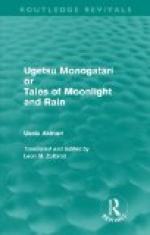|
This section contains 7,054 words (approx. 24 pages at 300 words per page) |

|
SOURCE: "Atmosphere and Thematic Conflict in Mizoguchi's "Ugetsu,"' in Cinema East: A Critical Study of Major Japanese Films, Fairleigh Dickinson University Press, 1983, pp. 103-22.
In the following essay, McDonald analyzes Mizoguchi's use of varying points of view in Ugetsu to capture the conflicting emotions brought on by civil war.
It has been said mat the strength of Japanese film lies in its creation of mood or atmosphere by presenting characters in their setting. Kenji Mizoguchi's major films exemplify this feature of Japanese cinema. Early examples in Mizoguchi's films include the final, nocturnal scene of the bridge from Osaka Elegy [Naniwa Ereji, 1936], the frequent takes of the small alley from Sisters of the Gion [Gion no Shimai, 1936], and the moon-viewing festival scene from Miss Oyu [Oyusama, 1951]. Ugetsu [Ugetsu Monogatari, 1953], the 1953 Venice Festival Silver Lion Prize winner, is, however, the best example of his assiduous evocation of mood. In...
|
This section contains 7,054 words (approx. 24 pages at 300 words per page) |

|


